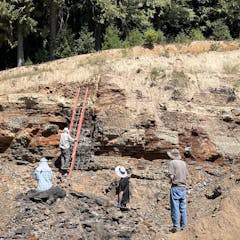
Articles on Space
Displaying 41 - 60 of 750 articles

Spaceplanes seemed out of favour when the shuttle was retired in 2011; they now seem to be making a comeback.

Projects under NASA’s CLPS program – including the Odysseus lander that made it to the lunar surface – will probe unexplored questions about the universe’s formation.

While NASA rovers on the surface of Mars look for hints of life, researchers back on Earth are studying ‘echoes of life’ from ancient basins – hoping that the two sites might be similar.

Mars has been a popular destination since space exploration began – and there are plenty of people who’d love to go there.

As space travel and lunar exploration becomes a near-future reality, we should consider the impact of human activities on the lunar environment.

Orbital resonance is kind of like musical harmony, but systems that display it are far more rare than songs with harmonic melodies.

Among the missions being planned is a huge helicopter drone to explore Saturn’s moon Titan.

The US might be facing international competition to be first to return to the Moon.

Sending human ashes and personal mementoes to the Moon is now possible, but it opens up a maze of legal and ethical conundrums.

When most of us left school there were still 9 planets – but we’ve come a long way since Pluto’s demotion. Here’s what’s next on the space agenda.

Japan is one of several countries that weren’t part of the space race of the 1950s and 1960s looking toward the Moon. They’ve now become the 5th country to have landed on its surface.

Japan’s space agency is landing its first lunar probe this week. This makes the Moon an increasingly busy target for spacefaring nations – with conflicting political stances among them.

NASA announced that the next two Artemis missions — Artemis II and III — will be delayed for safety reasons. However, Artemis IV remains on schedule.

Over two billion years from now, Earth will no longer be able to sustain life. A new study looks at how much life has ever existed and what this means for the discovery of new life-supporting planets.

You might hate winter, but at least you know what to expect every year. Other planets have wobbly axes that lead to wild, unpredictable seasons.

The Peregrine and Nova-C landers are due to carry out valuable science at two diverse lunar locations.

A telescope can reveal so much of the night sky, including Saturn’s rings and the Moon’s craters. But choosing the right telescope is a difficult decision – here’s what you need to know.

The sun is expected to reach its solar maximum in 2025. Recent auroras suggest that the maximum may be bigger than predicted.

Expect lots of space missions to launch this coming year, with exciting new science to follow.

Pictures of black holes have a white outline around them when photographed, due to one of black holes’ unique and key features.





